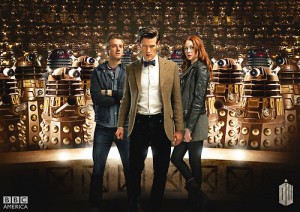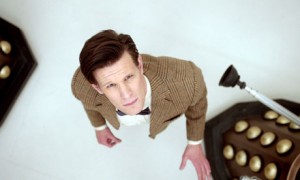
When I first heard that the opening episode of the new Doctor Who season was going to be about his long time enemies the Daleks, my heart sank a little.
It’s not that the Daleks aren’t scary, remorseless, and one of the most nightmarish baddies to emerge from a sci-fi writer’s overactive imagination, and thus worthy of ushering in a new Dr Who season; I just had this sense, and partly still do, that they have been used to death by a franchise that has shown it can create all new, chillingly soulless opponents such as the utterly amoral Weeping Angels in its sleep, and shouldn’t need to keep returning to the fetid well that houses the Daleks and the Cybermen, among others.
But return they did for this episode and you know what?
It was a triumph! It more than underlines that I should never be let into a scriptwriting session for Dr Who, at least not one where I have total veto power. (With the chance of me being allowed into a room full of Dr Who scriptwriters remote at best, I think we’re all fairly safe from me ever sitting across from Steven Moffat and torpedoing the BEST SCRIPT IDEA EVER.)
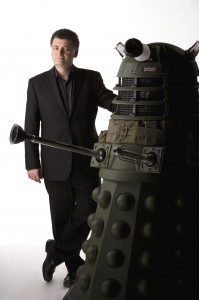
While Mr Moffat, who I think was worthy of being the successor to Russell T Davies as executive producer of the series, has demonstrated a gift for high-concept ambitious storyline that dazzle and impress, he hasn’t always drawn them together into a coherent, affecting narrative worthy of the idea itself.
But with “Asylum of the Daleks” he not only came up with a wholly original take on the Doctor’s long time enemies – Dalek-Human hybrids, a planet full of insane Daleks, and the Doctor being asked to save the Daleks; yes the Doctor did a triple take on that one – but crafted it into a an episode so compelling and emotionally rich that it ranks as one of the best of the modern era.
It began in suitably chilling fashion with a grand panoramic sweep across a still smoking post-apocalyptic Skaro, the original home planet of the Dalek. It was as effective a way of setting time and place as any I have seen, and made the clandestine meeting between the Doctor and a women claiming to be an escapee from a Dalek prison camp, and needing help to save her still-trapped daughter, all the more eerie.
Naturally of course, it was all a big trap, something the Doctor, though suspicious, only twigged to when she mentioned escaping from the prison camp. “No one escapes from a Dalek prison camp” he said seconds before we saw something no one had witnessed before – an eyestalk pushing through the forehead of the woman, quickly followed by the archetypal Dalek gun mount coming out of her raised hand.
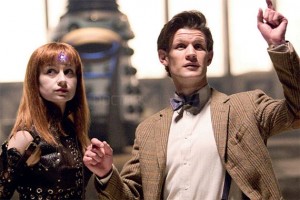
The emergence of this Dalek-Human hybrid or “puppet” – truth be told not much is left of the original human occupier of the body once the “hollowing out”, as the Doctor scornfully termed it, is completed – was the first such revelation of an episode replete with them.
The Doctor’s capture by the Daleks, followed by those of Rory and Amy, who had just signed divorce papers as the culmination of barely heralded, and poorly announced marital difficulties – see my review of the lead up vignettes to season seven, Pond Life – and their transfer to the Parliament of Daleks is done elegantly and quickly, and ushers in a breathtaking sequence where the Doctor, Amy and Rory find themselves are lifted up into a massive chamber full of tens of thousands of Daleks.
As Rory asks the Doctor “On a scale of 1 to 10, how much trouble are we in?” and the Doctor replies, “11”, they are greeted by the woman who kidnapped the Doctor, and the Prime Minister of the Daleks, who is not in a robotic shell, and all the creepier for it.
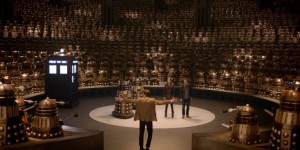
It is then that the Doctor, to his unending shock, is asked to “save the Daleks”, a bizarre and unexpected rallying cry that echoes round the chamber as thousands of Daleks repeat it over and over in their jarring electronic voices until all anyone can hear is a maddening cacophony of pleas for the Doctor’s help.
It emerges that they need the Doctor to go down to the legendary but assumed mythical planet known as the Asylum where all the Daleks who have “gone wrong” are sent. Given that “healthy” Daleks are only one straitjacket away from an asylum, devoid of every emotion bar hate, a planet of unhinged Daleks is not something anyone wants to contemplate, much less venture into, including, as the Doctor mockingly notes, the Daleks themselves.
The Doctor is surprised to learn that the Daleks don’t simply mercilessly dispatch their broken comrades to their version of the afterlife, and says as much to the Prime Minister who makes it clear that they can’t destroy “beauty of hatred”, a twisted veneration that sickens the Doctor.
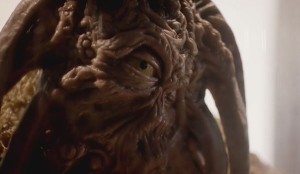
In a nod though to the morally grey areas that the modern iteration of Doctor Who has been prepared to entertain on more than one occasion, with an emphasis on the fact that the Doctor is prone to moral failings and not the always virtuous do-gooder he has been portrayed as in the past, when the Doctor expresses his revulsion at the motion of hatred being beautiful, and that they should just destroy it, the Prime Minister, aware of the devastating point he is about to make, and chuckling as he delivers it, says “But Doctor, that is why we have not destroyed you.”
But now of course is not the time or place for a discussion with the Daleks about what they do and don’t value, regardless of whether they have struck a nerve with the Doctor (which as his wincing as he walks away from the Prime Minister suggest they have), and so he, Rory and Amy submit to being beamed down to the planet via high energy particle beam that essentially slams them rather unceremoniously into the planet’s snowbound surface.
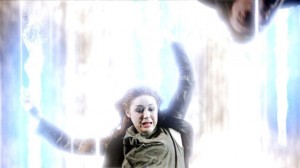
And this is where the fun begins because the discarded, unhinged Daleks are a nightmarishly demented lot, guarded by a nano cloud that instantly turns any organic creature, living or dead, into a Dalek “puppet” (from which the Daleks thoughtfully provide protection via a glowing blue wristband).
When our intrepid trio, once they’re reunited of course from their widely dispersed landing spots, aren’t running from shipwrecked “puppets” who still think they’re human till they’re activated (much like a enemy sleeper agent), or all manner of old model Daleks programmed with only aim, which is, you guessed it, to “Exterminate!” every non-Dalek in sight, they’re desperately looking for a way to turn off the forcefield (it can only be turned off from the inside) so the Daleks can blow the whole place to kingdom come.
And that is when they meet Oswin (Jenna Louise Coleman), a junior entertainment on a cosmic cruise ship, which crashed into the planet a year earlier, trapping her inside a sealed section and preventing her from being turned into a “puppet”. Or so she tells the Doctor, who quickly christens her “soufflé girl” when the peppy confident young women tells him she has passed her time listening to classical music, making the delicate French desserts, and helpfully for the Doctor and his companions, hacking into the Asylum’s computer systems, giving her control over doors, insight into the layout of the place and all sorts of other handy pieces of information.
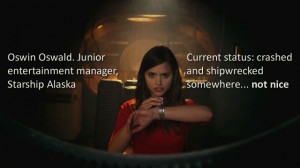
She comes to their rescue more than once, and when it comes time for the forcefield to be dropped, and the team to beam back to the Dalek mothership orbiting above split seconds before the Daleks vaporise the Asylum – naturally the Daleks have every intention of destroying the Doctor, or “Predator” as they call him – the Doctor rushes to save her.
Only to find, heartbreakingly, that she isn’t trapped in a crashed spaceship at all but rather has been turned, not into a “puppet” but a fully fledged Dalek. In denial about her conversion, Oswin has created a dreamworld where she is able to cook soufflés and wish her mum “Happy birthday”- which answers the question posed by both the Doctor and Rory about where she gets her eggs from; she doesn’t alas – and never confront who she is again.
It is a touching scene up there with the best of David Tennant’s time as the Doctor.
I had found Matt Smith’s attempts to meet his predecessor’s ability to be empathetic limited by scripts that didn’t give them the chance to show how deeply the Doctor is touched by what happens to the people he encounters (and hence why he fights so hard to save them, whatever his failings may be) but this time script and Matt’s willingness to suspend his omnipresent goofiness aligned perfectly and you felt deeply for Oswin and cried for the humanity she had brutally stolen from her.
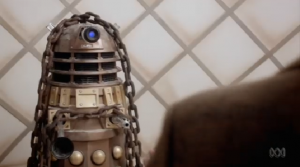
And you well understood why she retreated well into herself, and why when the Doctor forced her to confront that truth that her initially strong pronouncements that “I am human!” wavered to a reluctant but inexorable “Exterminate” before rebounding to a defiant declaration of innate humanity that drives her to erase all memory of the Doctor from the collective memory of all the Daleks and aids their escape before she retreats back into her Julia Child’s make believe world of cooking and classical music.
It is raw, anguished humanity writ so large and nakedly that you can’t help but weep for her tragic loss.
This inspiring statement of what it means to be human was unfortunately diluted a little by the somewhat rushed and trite nature of Rory and Amy’s reconciliation. Poised to divorce at the time of their abduction, but galvanised to declaring their true feelings for each other by Amy’s possible nano cloud-induced transformation into a Dalek “puppet”, they beamed off the Asylum a couple once more in love and devoted to each other.
I love a good love story so this one should have truly touched me since it meant not just the restoration of their marriage but also the halting of Amy’s Dalek-ising since the overpowering power of their love halted the tsunami of hatred that had been threatening to sweep the true of essence of Amy into oblivion.
Unfortunately it didn’t resonate as powerfully as it could, and came across as almost twee, and all too convenient (not to mention that Amy was in trouble again; time for a new angle for her perhaps?) and was the one weak point in a story that was, by and large, profoundly moving, revelatory and engrossing, and a sign that season 7 is off to a very good start indeed.
